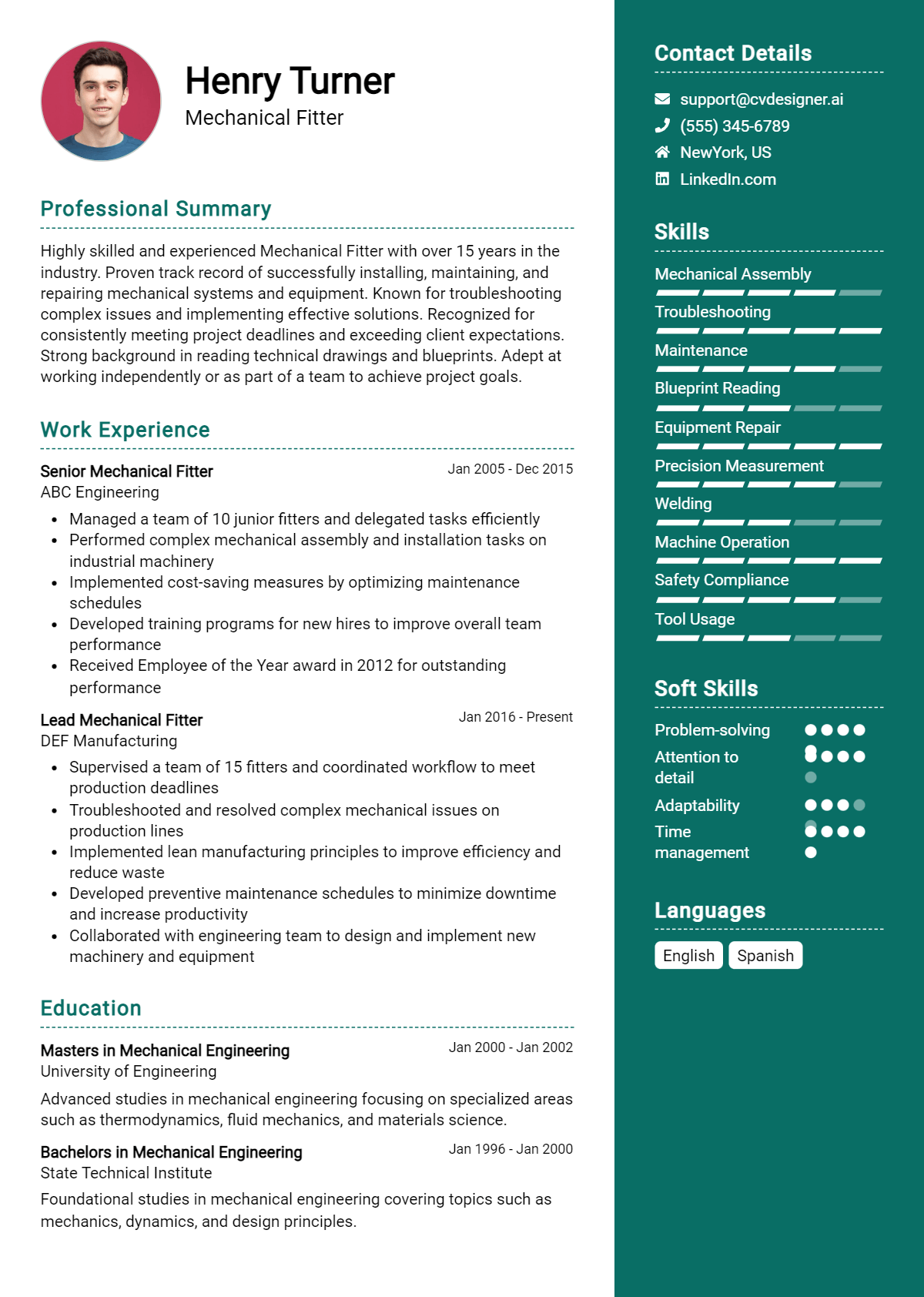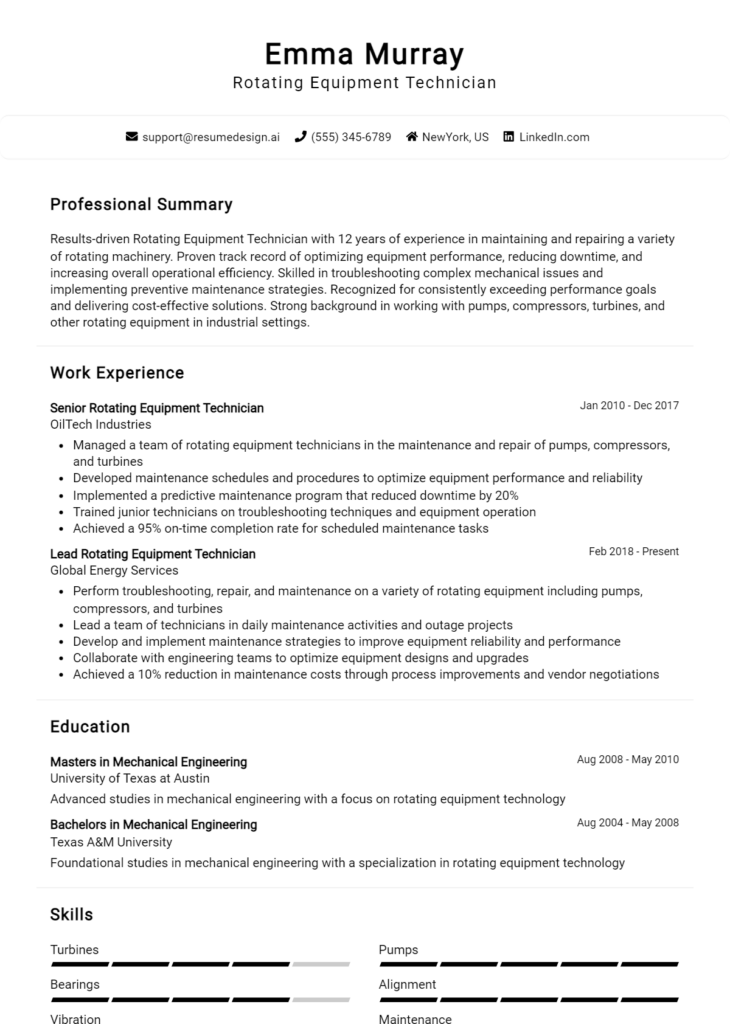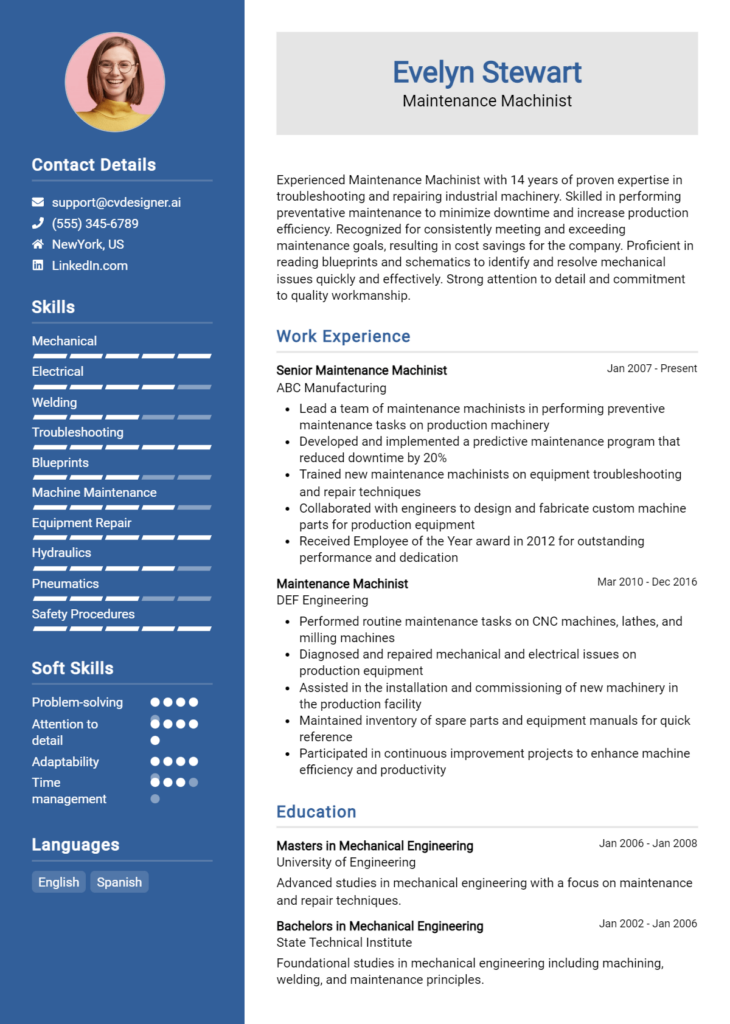Mechanical Fitter Core Responsibilities
A Mechanical Fitter plays a crucial role in ensuring the functionality and efficiency of machinery across various departments. Key responsibilities include assembling, installing, and maintaining mechanical systems while troubleshooting and resolving technical issues. This role requires strong operational and problem-solving skills, as well as the ability to collaborate effectively with engineering, production, and maintenance teams. A well-structured resume that highlights these competencies not only showcases a candidate's qualifications but also demonstrates their contribution to achieving organizational goals.
Common Responsibilities Listed on Mechanical Fitter Resume
- Assemble and install mechanical components and systems.
- Conduct routine maintenance and repairs on machinery.
- Troubleshoot mechanical failures and implement solutions.
- Read and interpret engineering drawings and schematics.
- Calibrate and adjust equipment to optimal performance levels.
- Ensure compliance with safety standards and regulations.
- Collaborate with engineers and other departments for project execution.
- Document maintenance activities and equipment performance.
- Utilize hand and power tools effectively and safely.
- Train and guide junior staff on best practices and procedures.
- Participate in continuous improvement initiatives.
- Assist in inventory management of spare parts and supplies.
High-Level Resume Tips for Mechanical Fitter Professionals
In the competitive field of mechanical fitting, a well-crafted resume serves as your gateway to securing an interview and ultimately landing your desired job. As the first impression you make on potential employers, your resume needs to effectively capture your skills, qualifications, and achievements in a concise and compelling manner. A thoughtfully designed resume not only showcases your technical abilities but also reflects your understanding of industry standards and practices. This guide will provide practical and actionable resume tips specifically tailored for Mechanical Fitter professionals, ensuring that you stand out in a crowded job market.
Top Resume Tips for Mechanical Fitter Professionals
- Tailor your resume for each job application by mirroring the language and requirements found in the job description.
- Highlight relevant experience, focusing on roles that directly relate to mechanical fitting and any specialized tasks you've performed.
- Quantify your achievements with specific metrics, such as the percentage of efficiency improvements or cost reductions you contributed to in previous roles.
- Showcase industry-specific skills, including knowledge of tools, machinery, and safety protocols pertinent to mechanical fitting.
- Incorporate keywords from the job posting to enhance your resume's visibility in applicant tracking systems (ATS).
- Include certifications and training relevant to mechanical fitting, such as HVAC, welding, or specific machinery operation qualifications.
- Emphasize soft skills that are important in the field, such as teamwork, problem-solving, and communication abilities.
- Use a clean and professional layout, ensuring easy readability and a logical flow of information.
- List any relevant projects or achievements that demonstrate your hands-on experience and success in mechanical fitting roles.
By implementing these tips, you can significantly enhance your resume and increase your chances of landing a job in the Mechanical Fitter field. A strategic approach to resume writing will not only highlight your qualifications but also demonstrate your commitment to the profession, setting you apart from other candidates and making a strong case for your candidacy.
Why Resume Headlines & Titles are Important for Mechanical Fitter
In the competitive field of mechanical fitting, having a well-crafted resume is essential to stand out from the crowd. One of the most important elements of a resume is the headline or title, which serves as the first impression for hiring managers. A strong headline can immediately grab attention and succinctly summarize a candidate's key qualifications in one impactful phrase. It should be concise, relevant, and directly related to the job being applied for, allowing the candidate to make a strong statement about their skills and experience right from the start.
Best Practices for Crafting Resume Headlines for Mechanical Fitter
- Keep it concise: Aim for a headline that is no more than 10 words.
- Be role-specific: Include keywords relevant to the mechanical fitter position.
- Highlight key strengths: Focus on your top skills or accomplishments.
- Use action-oriented words: Start with powerful verbs to convey confidence.
- Avoid jargon: Use clear and straightforward language for better understanding.
- Tailor to the job: Customize your headline for each job application.
- Showcase relevant certifications: If applicable, include notable credentials.
- Maintain professionalism: Ensure the tone aligns with industry standards.
Example Resume Headlines for Mechanical Fitter
Strong Resume Headlines
Experienced Mechanical Fitter Specializing in Precision Engineering
Certified Mechanical Fitter with 10 Years in Heavy Machinery Repair
Detail-Oriented Mechanical Fitter with Proven Troubleshooting Skills
Skilled Mechanical Fitter Committed to Safety and Quality Standards
Weak Resume Headlines
Just Another Mechanical Fitter
Mechanical Fitter Looking for Work
The strong headlines are effective because they clearly convey specific skills, experience, and accomplishments that directly relate to the mechanical fitter role, making a strong case for the candidate's suitability. In contrast, the weak headlines fail to impress due to their vagueness and lack of specificity, which do not provide any compelling reasons for hiring managers to consider the candidate further. A well-crafted headline can be the difference between getting noticed or overlooked in a sea of applicants.
Writing an Exceptional Mechanical Fitter Resume Summary
A well-crafted resume summary is crucial for a Mechanical Fitter as it serves as the first impression a candidate makes on hiring managers. This brief section of the resume quickly captures attention, showcasing essential skills, relevant experiences, and notable accomplishments that align with the job role. An impactful summary should be concise and tailored specifically to the position being applied for, helping candidates stand out in a competitive job market.
Best Practices for Writing a Mechanical Fitter Resume Summary
- Keep it concise: Aim for 2-4 sentences that encapsulate your qualifications.
- Quantify achievements: Use numbers and statistics to highlight your accomplishments.
- Focus on relevant skills: Tailor your summary to include skills that match the job description.
- Use action verbs: Start sentences with strong action verbs to convey your contributions effectively.
- Highlight industry experience: Mention specific sectors you've worked in that relate to the position.
- Showcase certifications: Include any relevant certifications that enhance your qualifications.
- Express passion for the role: Convey enthusiasm for mechanical fitting and the specific company or industry.
- Proofread: Ensure there are no grammatical errors or typos that could detract from professionalism.
Example Mechanical Fitter Resume Summaries
Strong Resume Summaries
Detail-oriented Mechanical Fitter with over 8 years of experience in maintaining and repairing industrial machinery. Successfully reduced equipment downtime by 30% through proactive maintenance strategies and troubleshooting skills.
Skilled Mechanical Fitter with a strong background in hydraulic systems and pneumatic tools. Consistently achieved a 95% customer satisfaction rating by delivering high-quality installations and repairs on time.
Proficient Mechanical Fitter with extensive experience in assembling and disassembling complex machinery. Improved assembly line efficiency by 20% through the implementation of streamlined processes and attention to detail.
Dedicated Mechanical Fitter with a proven track record of completing projects ahead of deadlines. Certified in welding and fabrication, with a focus on enhancing safety and compliance in all engineering practices.
Weak Resume Summaries
I am a Mechanical Fitter looking for a job where I can use my skills.
Mechanical Fitter with some experience. I work hard and am reliable.
The strong resume summaries effectively highlight quantifiable achievements, specific skills, and direct relevance to the role of a Mechanical Fitter, making them compelling to hiring managers. In contrast, the weak summaries lack details, do not provide measurable outcomes, and come across as generic, failing to demonstrate the candidate's unique qualifications or contributions to potential employers.
Work Experience Section for Mechanical Fitter Resume
The work experience section of a Mechanical Fitter resume is crucial as it provides a platform for candidates to demonstrate their technical skills and competencies developed throughout their career. This section not only highlights a candidate's practical experience but also showcases their ability to manage teams and deliver high-quality products in various industrial settings. By quantifying achievements and aligning their experiences with industry standards, candidates can effectively convey their value to potential employers and set themselves apart in a competitive job market.
Best Practices for Mechanical Fitter Work Experience
- Use specific technical terminology relevant to the mechanical fitting industry.
- Quantify achievements with metrics such as production rates, downtime reduction, or cost savings.
- Highlight leadership roles or team collaboration that led to successful project completions.
- Include relevant certifications or training that enhance technical qualifications.
- Tailor the work experience to align with the job description of the role you're applying for.
- Focus on problem-solving experiences that demonstrate critical thinking and innovation.
- Showcase a range of mechanical skills, from assembly to maintenance and repair.
- Maintain a clear and concise format for easy readability and comprehension.
Example Work Experiences for Mechanical Fitter
Strong Experiences
- Led a team of 5 in the installation and maintenance of a new assembly line, reducing production downtime by 30% within the first quarter.
- Implemented a predictive maintenance program that decreased equipment failure rates by 25%, resulting in a savings of $50,000 annually.
- Collaborated with engineering teams to design and fabricate custom mechanical components, improving product quality and reducing waste by 15%.
- Trained and mentored new hires, enhancing team efficiency and reducing onboarding time by 20%.
Weak Experiences
- Responsible for fitting machines and equipment.
- Worked as part of a team on various projects.
- Performed maintenance tasks as needed.
- Assisted in the assembly of products.
The examples of strong experiences are considered effective because they include specific achievements, quantifiable results, and evidence of leadership and collaboration, making them impactful and relevant. In contrast, the weak experiences lack detail, specificity, and measurable outcomes, failing to convey the candidate's true capabilities and contributions in the mechanical fitting field.
Education and Certifications Section for Mechanical Fitter Resume
The education and certifications section of a Mechanical Fitter resume is crucial as it provides potential employers with insight into the candidate's academic foundation and professional qualifications. This section not only highlights relevant degrees and specialized certifications but also underscores the candidate's commitment to continuous learning and professional development. By showcasing pertinent coursework and industry-recognized credentials, candidates can significantly enhance their credibility and demonstrate their alignment with the job role, making them more appealing to hiring managers.
Best Practices for Mechanical Fitter Education and Certifications
- Focus on relevant degrees and certifications that directly correlate with mechanical fitting.
- Include the date of completion for each qualification to showcase your most up-to-date knowledge.
- Highlight any specialized training programs or apprenticeships that provide hands-on experience.
- List certifications from recognized industry organizations to enhance credibility.
- Provide brief descriptions of relevant coursework that applies to mechanical fitting tasks.
- Organize the section in reverse chronological order to emphasize recent qualifications.
- Consider including ongoing education initiatives, such as workshops or seminars.
- Avoid irrelevant qualifications that do not pertain to the mechanical fitting field.
Example Education and Certifications for Mechanical Fitter
Strong Examples
- Diploma in Mechanical Engineering, ABC Technical Institute, Graduated: May 2022
- Certified Mechanical Fitter, National Institute of Mechanical Trades, Issued: June 2023
- Completion of Advanced Welding Techniques Course, XYZ Vocational School, Completed: March 2022
- OSHA 30-Hour General Industry Certification, Issued: January 2023
Weak Examples
- Bachelor's Degree in History, DEF University, Graduated: May 2019
- Certification in Office Administration, GHI Community College, Issued: August 2020
- High School Diploma, JKL High School, Graduated: June 2015
- Online Course in Graphic Design, Completed: February 2021
The examples provided illustrate the distinction between strong and weak educational qualifications and certifications. Strong examples are directly related to mechanical fitting, showcasing relevant degrees, industry-recognized certifications, and specialized training that enhances the candidate's capabilities. In contrast, weak examples reflect qualifications that are outdated or unrelated to the mechanical fitting profession, which may detract from the candidate's suitability for the role and fail to demonstrate their expertise in the field.
Top Skills & Keywords for Mechanical Fitter Resume
When crafting a resume for a Mechanical Fitter position, showcasing the right skills is crucial. Employers look for candidates who not only possess technical expertise but also demonstrate the ability to work well within a team and adapt to various situations. A well-rounded skill set highlights your qualifications and can set you apart from other candidates. By emphasizing both hard and soft skills, you can present a comprehensive picture of your capabilities, making it easier for hiring managers to see your potential contributions to their organization. For more insights into essential skills, take a look at this skills guide.
Top Hard & Soft Skills for Mechanical Fitter
Hard Skills
- Mechanical assembly
- Blueprint reading
- Basic welding techniques
- Precision measuring
- Hydraulic and pneumatic systems knowledge
- Equipment troubleshooting
- CNC machining
- Fabrication skills
- Equipment maintenance
- Technical drawing interpretation
- Proficiency in hand and power tools
- Knowledge of safety protocols
- Installation of mechanical systems
- Quality control processes
- Troubleshooting electrical systems
- Computer-aided design (CAD) familiarity
Soft Skills
- Attention to detail
- Problem-solving abilities
- Teamwork and collaboration
- Time management
- Effective communication
- Adaptability
- Critical thinking
- Strong work ethic
- Initiative
- Conflict resolution
- Dependability
- Organizational skills
- Customer service orientation
- Ability to follow instructions
- Positive attitude
- Willingness to learn
- Stress management
In addition to highlighting these essential skills, it's important to also focus on your work experience to demonstrate how you have applied these skills in real-world scenarios. This combination will make your resume more compelling and relevant to potential employers.
Stand Out with a Winning Mechanical Fitter Cover Letter
Dear [Hiring Manager's Name],
I am writing to express my interest in the Mechanical Fitter position at [Company Name] as advertised on [where you found the job listing]. With over [X years] of experience in mechanical assembly, maintenance, and repair, I have honed my skills in diagnosing mechanical issues, performing preventive maintenance, and ensuring equipment operates at peak efficiency. My hands-on experience, combined with a solid foundation in engineering principles, makes me a strong candidate for this role.
At my previous position with [Previous Company Name], I successfully led a team in overhauling complex machinery, reducing downtime by 30% through meticulous planning and execution of maintenance schedules. I take pride in my attention to detail and my ability to troubleshoot mechanical problems quickly and effectively. My expertise in reading technical drawings and schematics allows me to understand the intricacies of machinery, ensuring that all installations and repairs are completed to the highest standards.
I am particularly drawn to [Company Name] because of its commitment to innovation and excellence in the industry. I am excited about the opportunity to contribute my skills in mechanical fitting to your team, ensuring that all equipment is functioning optimally and contributing to the overall success of your operations. I am confident that my proactive approach and dedication to quality will be an asset to your organization.
Thank you for considering my application. I look forward to the opportunity to discuss how my experience and skills align with the needs of your team at [Company Name]. I am eager to bring my background in mechanical fitting to your esteemed company and contribute to its continued success.
Sincerely,
[Your Name]
[Your Contact Information]
Common Mistakes to Avoid in a Mechanical Fitter Resume
When crafting a resume for a Mechanical Fitter position, it's essential to present your skills and experiences clearly and professionally. However, many candidates make common mistakes that can hinder their chances of landing an interview. Understanding these pitfalls can help you create a more effective resume that showcases your qualifications. Here are some mistakes to avoid:
Generic Objective Statement: Using a vague or generic objective statement doesn't effectively communicate your specific goals or how you can contribute to the company. Tailor your statement to align with the job you're applying for.
Failure to Highlight Relevant Skills: Omitting crucial mechanical skills, such as proficiency in specific tools or techniques, can make your resume less compelling. Be sure to list skills that are directly relevant to the job description.
Overloading with Technical Jargon: While it's important to demonstrate technical expertise, using too much jargon can make your resume difficult to read. Strike a balance by using clear language that conveys your knowledge without alienating the reader.
Ignoring Quantifiable Achievements: Simply listing job duties without including specific achievements can weaken your resume. Use quantifiable results, such as "Reduced downtime by 15% through efficient maintenance practices," to demonstrate your impact.
Inconsistent Formatting: A disorganized or inconsistent format can distract from your qualifications. Ensure that your resume has a uniform structure, including font, spacing, and bullet points, to enhance readability.
Neglecting Soft Skills: Focusing solely on technical skills can overlook the importance of soft skills like teamwork, communication, and problem-solving. Highlight these skills to show that you are well-rounded and can collaborate effectively.
Lack of Tailoring for Each Application: Sending the same resume for multiple job applications can be detrimental. Tailor your resume for each position to reflect the specific requirements and emphasize your most relevant experiences.
Omitting Certifications and Training: Failing to include relevant certifications or training can be a missed opportunity. Be sure to list any licenses or courses that enhance your qualifications and demonstrate your commitment to professional development.





















